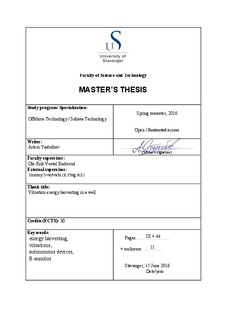| dc.contributor.author | Yastrebov, Artem | |
| dc.date.accessioned | 2016-09-29T07:59:44Z | |
| dc.date.available | 2016-09-29T07:59:44Z | |
| dc.date.issued | 2016-06 | |
| dc.identifier.uri | http://hdl.handle.net/11250/2411656 | |
| dc.description | Master's thesis in Offshore technology: Marine and subsea technology | nb_NO |
| dc.description.abstract | The main objective of this thesis is to study the possible solution for the supply of electric energy to autonomous systems in a well via vibration harvesting modules.
Some autonomous systems such as pressure/temperature sensors located for example in the B-annulus, should be powered in order to function. This represents a significant challenge in in
subsea wells, since penetrations in subsea wellheads are not allowed by the current standards such as API 17D. One of the solutions to the power supply challenge is to use energy harvesting modules. Since during drilling and production phases multiple sources of vibrations are present these modules can potentially be used.
The use of vibration harvesting modules for powering autonomous sensors in inaccessible locations can potentially decrease complexity of monitoring systems, significantly reduce installation time and costs.
In order to identify to what extend the vibration harvesting module can be used for the power supply an experiment of using the Vibration Harvesting Module (VHM) is performed. The experiment setup which was used to estimate certain parameters of the vibration harvesting module, calculations justifying the choice of equipment and experimental procedure are provided in the thesis. The experiments consisted of three parts: two experiments with induced vibrations by using two different vibration motors and one experiment with natural oscillations. It was concluded that natural oscillations test can give such important characteristics of the system as resonance frequency and Q-factor. By using these parameters the effective range of the vibration harvesting module can be estimated. Information concerning internal resistance and power output can be obtained only by testing, as it was demonstrated. Resonance frequency and effective operation range were obtained by two different tests and results of those tests were comparatively similar. It has been demonstrated that while Thevenin’s equivalent can quite accurately describe power output characteristics this mathematical model fails to describe internal resonance due to its dependency on a current. Many other factors should be studied in order to properly describe both power output and internal resistance using the same model. | nb_NO |
| dc.language.iso | eng | nb_NO |
| dc.publisher | University of Stavanger, Norway | nb_NO |
| dc.relation.ispartofseries | Masteroppgave/UIS-TN-IKM/2016; | |
| dc.rights | Navngivelse 3.0 Norge | * |
| dc.rights.uri | http://creativecommons.org/licenses/by/3.0/no/ | * |
| dc.subject | offshore teknologi | nb_NO |
| dc.subject | undervannsteknologi | nb_NO |
| dc.subject | subsea technology | nb_NO |
| dc.subject | energy harvesting | nb_NO |
| dc.title | Vibration energy harvesting in a well | nb_NO |
| dc.type | Master thesis | nb_NO |
| dc.subject.nsi | VDP::Technology: 500::Marine technology: 580::Offshore technology: 581 | nb_NO |

